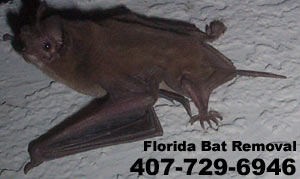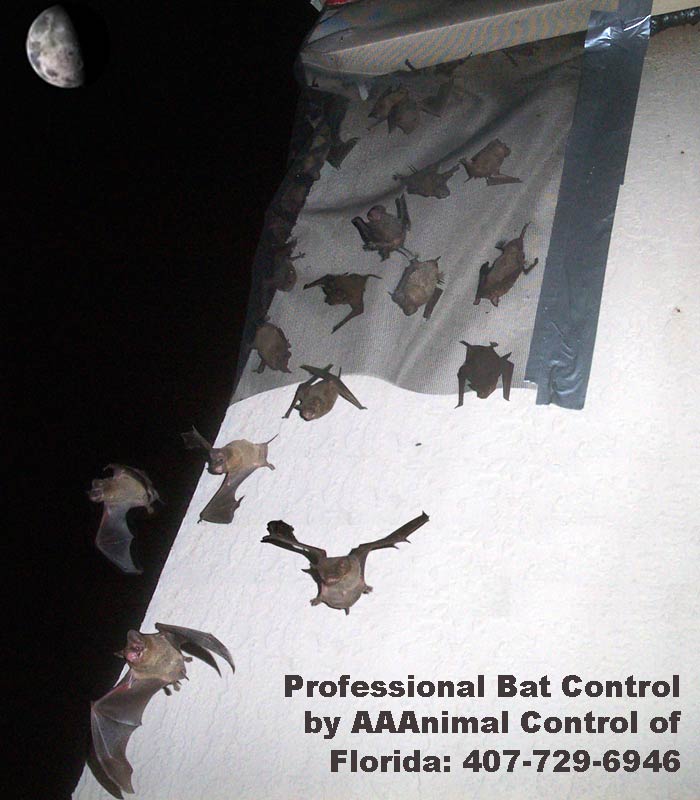-
info@aaanimalcontrol.com
Call us for help in your town
Humane Wildlife Education
Brazilian Free-Tailed Bat - tadarida brasiliensis
Click here for my nationwide list of 100's of professional bat control experts!
Also known as the Mexican Free Tail Bat
Need bat removal in your hometown? We service over 500 USA locations! Click here to hire us in your town and check prices - updated for year 2020. Description: The Brazilian Free-tailed Bat is so named because it
possesses a tail free and protruding beyond the uropatagium (hind membrane). The Brazilian Free-Tailed Bat
has short and velvety dark brown fur on the back, and lighter fur on the belly. Its lips are furrowed by vertical grooves, it has 38 teeth, and the nostrils are surrounded by elevated skin. Its
narrow, pointed wings permit fast flight. The toes of the hind feet have strong, recurved bristles which are used to groom the fur. The free-tailed bat has a strong musky odor, which
most people can detect when near an active colony. Size: Adults may attain a total length 90-108 mm; tail 10-40 mm; hind foot 8-11 mm; ear 13-19 mm; weight 8-14 grams. This is one of North America's smaller bats, and is often
mistaken for a baby bat by amateurs.
Description: The Brazilian Free-tailed Bat is so named because it
possesses a tail free and protruding beyond the uropatagium (hind membrane). The Brazilian Free-Tailed Bat
has short and velvety dark brown fur on the back, and lighter fur on the belly. Its lips are furrowed by vertical grooves, it has 38 teeth, and the nostrils are surrounded by elevated skin. Its
narrow, pointed wings permit fast flight. The toes of the hind feet have strong, recurved bristles which are used to groom the fur. The free-tailed bat has a strong musky odor, which
most people can detect when near an active colony. Size: Adults may attain a total length 90-108 mm; tail 10-40 mm; hind foot 8-11 mm; ear 13-19 mm; weight 8-14 grams. This is one of North America's smaller bats, and is often
mistaken for a baby bat by amateurs.  Range: The species is one of the most widely distributed mammalian species in the Western Hemisphere. Northern limits extend from southern Oregon, Nevada, Utah to Nebraska,
Mississippi, to southern North Carolina. From this northern swath, the Brazilian Free-tailed Bat ranges southward through most of Central America, Antilles, through most of western
South America to central Chile and east to the coastal provinces of Brazil. Populations of the Brazilian Free-tailed Bat in North America exhibit two types of seasonal movement;
they stay in their general vicinity year-round, or they migrate. Brazilian Free-tailed Bats ranging eastward from eastern Texas, including Florida, do not migrate.
Most of the largest
congregations of these bats are found in a few, precious caves. Here if Florida, I deal with this species state-wide, but I seem to encounter higher numbers of bats near the
coastlines.
Range: The species is one of the most widely distributed mammalian species in the Western Hemisphere. Northern limits extend from southern Oregon, Nevada, Utah to Nebraska,
Mississippi, to southern North Carolina. From this northern swath, the Brazilian Free-tailed Bat ranges southward through most of Central America, Antilles, through most of western
South America to central Chile and east to the coastal provinces of Brazil. Populations of the Brazilian Free-tailed Bat in North America exhibit two types of seasonal movement;
they stay in their general vicinity year-round, or they migrate. Brazilian Free-tailed Bats ranging eastward from eastern Texas, including Florida, do not migrate.
Most of the largest
congregations of these bats are found in a few, precious caves. Here if Florida, I deal with this species state-wide, but I seem to encounter higher numbers of bats near the
coastlines.Reproduction: A single, relatively large, young is born in late May or early of June after a gestation period of about three months. The young are left in the nursery where they are apparently, but not always, fed indiscriminately, by any lactating female, in contrast to many other colonial bats. It grows rapidly and is capable of flight before it is fully grown, usually within 8 weeks. Breeding occurs from February to mid-April. Males become sexually mature in 18 to 22 months, while females mature in nine months.
Habitats: These bats utilize caves, mine tunnels, old wells, hollow trees, human habitations, bridges, and other buildings as daytime retreats. The prime necessity for a roost seems to be some relatively dark, dry retreat where from several dozen to several million individuals can hang up in close association and have an unobstructed space below into which they can drop when taking wing. Hollows under the roofs, spaces between downtown buildings, attics, narrow spaces between signs and buildings, and spaces in the walls of buildings all offer suitable refuge sites for these bats. Because of their frequent occurrence about and in buildings, they frequently are termed "house bats."
Health Hazards: Because Brazilian Free-tailed Bats tend to aggregate in high numbers, guano can accumulate. Guano serves as a fertile breeding ground for the fungus Histoplasma capsulatum, which can cause the infection Histoplasmosis in humans. Bats can carry a number of disease transmitting parasites. Brazilian Free-tailed bats are also known carriers of rabies.


AAAnimal Control is a professional nuisance wildlife control company located in Orlando, FL. We offer solutions to wildlife problems throughout the Greater Orlando Florida area, and specialize in bat control. We offer professional bat control & removal for the entire state of Florida. Wildlife services include animal trapping, capture & removal, plus animal damage repairs and preventative measures. We also offer biological cleanup and many other services. Give us a call at 407-729-6946 any time to discuss your wildlife management issue and schedule an appointment. You can always browse this site for more details and info, and you can even check out prices ahead of time. If you live elsewhere in the US and have found this site and need a local trapper in your area, click here for a nationwide list of 100's of professional bat removal experts.



















